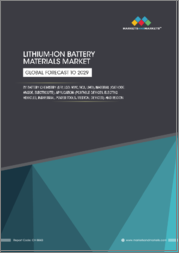
|
시장보고서
상품코드
1526416
<2024> LIB 전해액 리튬염/첨가제 기술 동향 및 시장 전망(-2035년)<2024> LIB Electrolyte Li-salts, Additives Technology Trends & Market Outlook |
||||||
전해액은 리튬이온 이차전지의 4대 핵심소재 중 하나입니다. 이를 살펴보면 크게 용매 (Solvents), 리튬염 (Lithium Salts), 첨가제 (Additives)로 구성되어 있습니다.
일반적으로 리튬이온 이차전지용 유기전해액에 중요하게 요구되는 특성은 리튬이온의 전도도와 전기화학적 안정성이라 할 수 있습니다. 따라서 어떠한 전극을 사용하더라도 리튬이온의 이동도가 우수하고 전지구동전위 범위 내에서 심각한 전기화학적인 분해반응을 하지 않는 전해액을 사용해야 우수한 전지성능을 확보할 수 있습니다.
리튬이온 이차전지에서 리튬염은 전해액의 주요 구성 요소로서 배터리의 성능과 안정성을 결정짓는 중요한 역할을 합니다. 리튬염은 리튬이온의 전도성을 확보하여 전지 내에서 전하를 효과적으로 전달하는 매개체로 작용합니다. 대표적인 리튬염으로는 리튬 헥사플루오로포스페이트(LiPF6), 리튬 트리플루오로메탄설포네이트(LiTFSI), 리튬 비스(플루오로설포닐)이미드(LiFSI) 등이 있습니다. LiPF6는 높은 전도성과 저온에서의 안정성 덕분에 널리 사용되지만, 고온에서의 열적 불안정성과 가수분해에 따른 부작용이 문제로 지적됩니다.
이에 대한 대안으로 LiFSI와 같은 리튬염이 연구되고 있으며, 이들은 우수한 전도성과 열적 안정성을 제공합니다. LiFSI는 특히 LiPF6보다 우수한 화학적 및 열적 안정성을 보이며, 높은 이온 전도도와 낮은 전기저항을 특징으로 합니다. 또한, LiFSI는 낮은 점도와 뛰어난 전기화학적 안정성을 제공하여, 전지의 수명과 안전성을 향상시키는 데 기여합니다. 그러나 제조 비용과 부식성 등의 단점 또한 상존하므로 적절한 조합이 배터리 성능과 안전성 향상에 관건이라 할 수 있습니다.
첨가제는 리튬이온 이차전지의 전해액 성능을 향상시키기 위해 중요한 역할을 합니다. 첨가제는 주로 전해액의 안정성, 전도도, 계면 특성 등을 개선하기 위해 사용됩니다. 예를 들어, 고체전해질 계면층(SEI) 형성을 촉진하는 첨가제는 전지의 수명과 안정성을 향상시키는 데 기여합니다. 대표적인 첨가제로는 플루오로에틸렌카보네이트(FEC), 비닐렌카보네이트(VC) 등이 있으며, 이들은 SEI층을 형성하여 음극의 안정성을 높입니다다. 또한, 황화물 기반 첨가제는 양극의 안정성을 개선하여 고전압에서의 성능을 향상시킵니다.
최근 연구에서는 다양한 새로운 첨가제가 개발되고 있으며, 이들의 조합을 통해 전지 성능을 최적화하려는 노력이 지속되고 있습니다. 예를 들어, LiFSI와 함께 사용되는 특정 첨가제는 전해액의 전기화학적 윈도우를 넓히고, 높은 에너지 밀도를 유지하면서도 사이클 수명을 연장시킬 수 있습니다. 이러한 첨가제와의 시너지는 리튬이온 이차전지의 에너지 밀도, 수명, 안전성 등 다양한 성능 지표를 개선하는 데 핵심적인 요소로 작용합니다. LiFSI와 첨가제의 혁신적인 조합은 차세대 고성능 리튬이온 이차전지의 상용화를 앞당기는 중요한 역할을 할 것입니다.
이렇듯 전해액에서 핵심적인 역할을 하는 리튬염과 첨가제는 과거 일본 업체가 대부분을 공급했으나, 현재 중국 업체들이 생산능력을 크게 확대하면서 판도가 바뀌게 되었습니다. 가장 일반적으로 사용되는 범용 리튬염인 LiPF6 같은 경우, 과거에는 일본의 Stella Chemifa, Morita, Kanto Denka 및 한국의 후성 등 소수의 업체만 배터리급 품질의 제품을 공급할 수 있었으나, 지난 몇 년간 Tinci Materials, DFD 등의 대형 업체들이 리튬염 기술 개발 및 생산능력의 확대로 현재 시장의 절대적 강자가 되었습니다. 특수 리튬염 (LiFSI 등) 및 첨가제의 경우에도 과거 일본의 Mitsubishi Chemical, Central Glass, Nippon Shokubai 등 원천 특허를 보유한 업체들이 거의 독점했으나, 현재는 한국의 천보, 그리고 중국의 HSC, Genyuan 등의 업체가 우회 특허 또는 자체 기술을 바탕으로 시장 점유율을 지속적으로 확대하고 있습니다.
본 리포트에서 당사는 리튬이온 이차전지용 전해액을 구성하는 요소 중 가장 핵심적인 리튬염과 첨가제의 기술적 정보를 상세하게 정리하였으며, 당사의 다양한 전망 자료를 기반으로 리튬염 및 첨가제에 대한 시장을 다각도로 전망하여 독자들이 전체적인 시장 상황을 파악하는 데 도움을 주고자 하였습니다.
마지막으로, 주요 리튬염 및 첨가제 제조업체의 사업 현황과 향후 계획을 정리함으로써 이 분야의 연구자와 관심있는 분들에게 기술부터 시장에 이르는 넓은 범위의 통찰력을 제공하고자 노력하였습니다.
본 보고서의 Strong Point
- 1. 리튬염 및 첨가제의 주요 특성 및 응용 등 상세한 기술 정보 수록
- 2. 당사의 전망자료와 다양한 자료를 근거로 한 시장전망을 통해 객관적인 데이터 제공
- 3. 리튬염 및 첨가제 시장의 주요 공급현황과 전망 파악 가능
- 4. 한중일 주요 Player의 제품 및 생산 현황에 대한 상세한 정보 수록
목 차
Chapter Ⅰ. 개요
- 1.1 배경
- 1.2 LIB 전해액 개요
- 1.3 전해액 구성요소 및 특성
Chapter Ⅱ. 리튬염 / 첨가제 개발 동향
- 2.1 리튬염 개발 동향
- 2.1.1 리튬염 개요
- 2.1.2 리튬염 종류별 기능 및 특징
- 2.2 첨가제 개발 동향
- 2.2.1 고전압 양극향 피막 형성용 첨가제
- 2.2.2 저전압 음극향 피막 형성용 첨가제
- 2.2.3 환원분해형 화합물에 의한 음극 SEI 형성과정
- 2.2.4 구조적으로 파괴된 SEI 층의 재생성하는 기능성 첨가제
- 2.2.5 전지 성능 저하를 일으키는 반응성 화합물 제거형 첨가제
- 2.2.6 High-Ni계 양극 계면 안정화를 위한 전해액 첨가제
- 2.2.7 출력 특성 향상을 위한 전해액 첨가제
- 2.2.8 LiFSI 염을 사용하는 전해액
- 2.2.9 열 안정성 향상을 위한 난연성 첨가제
- 2.2.10 고용량 음극 계면 안정화를 위한 첨가제
- 2.2.11 Ni-rich and High Voltage System 첨가제 (w/ or w/o SiOx)
- 2.2.12 실리콘 음극용 첨가제
- 2.2.13 LFP 양극용 첨가제
- 2.2.14 LMFP 양극용 첨가제
- 2.2.15 LFP & LMFP 양극용 HF, Metal scavenger 기능 첨가제
- 2.2.16 LMR 양극용 첨가제
- 2.2.17 안전성용 첨가제
- 2.3 중대형 LIB 시장 - ESS
- 2.3.1 F전해질 (LiFSI)
- 2.3.2 VC (Vinylene Carbonate) 첨가제
- 2.3.3 FEC (Fluoroethylene Carbonate) 첨가제
- 2.3.4 VEC (Vinylethylene Carbonate) 첨가제
- 2.4 전고체 전지 첨가제
- 2.4.1 전고체 전지의 필요성
- 2.4.2 전고체 전지의 Issue
- 2.4.3 Solid Electrolytes 의 해결책
- 2.4.4 전고체 전지 배터리 개발 (양극, 음극 표면 개질)
- 2.4.5 전고체 전지의 수명 개선 연구
- 2.4.6 전고체 전지 업체별 개발 현황
Chapter Ⅲ. 리튬염 / 첨가제 시장 동향 및 전망
- 3.1 LIB 전해액 시장 배경
- 3.1.1 전방산업 전망
- 3.1.2 수급 전망
- 3.1.3 전해액 구성소재별 전망
- 3.1.4 Cost 구조
- 3.2 리튬염/첨가제 시장 현황 및 전망
- 3.2.1 범용 리튬염 (LiPF6)
- 3.2.2 특수 리튬염
- 3.2.3 전해액 첨가제
- 3.3 리튬염/첨가제 공급 현황 및 전망
- 3.3.1 범용 리튬염 (LiPF6) 생산 현황 및 전망
- 3.3.2 특수 리튬염 (LiFSI) 생산 현황 및 전망
- 3.3.3 전해액 첨가제 (VC, FEC) 생산 현황 및 전망
Chapter Ⅳ. 리튬염 / 첨가제 생산업체 현황
- 4.1 한국 업체
- Dongwha Electrolyte / Enchem / Foosung / Chunbo / Chemtros / Duksan Techopia / EPCHEMTECH / PGT
- 4.2 중국 업체
- Tinci Materials / HSC New Energy / Shandong Genyuan / Yongtai Technology / Do-Fluoride New Materials / Tonze New Energy
- 4.3 일본 업체
- Mitsubishi Chemical / Central Glass / Nippon Shokubai / Kanto Denka / Stella Chemifa
- 4.4 (참고) 특수 리튬염 주요 특허 및 개발 전략
Chapter Ⅴ. Reference
Electrolyte is one of the 4 major materials of lithium-ion secondary batteries. It is largely composed of solvents, lithium salts, and additives.
In general, the important characteristics required for organic electrolytes for lithium-ion secondary batteries are lithium-ion conductivity and electrochemical stability. Therefore, regardless of the electrode used, an electrolyte with excellent lithium-ion mobility and no serious electrochemical decomposition reaction within the battery operating potential range must be used to secure excellent battery performance.
In lithium-ion secondary batteries, lithium salts are the main components of the electrolyte and play an important role in determining the performance and stability of the battery. Lithium salts secure the conductivity of lithium ions and act as a medium that effectively transfers charges within the battery. Representative lithium salts include lithium hexafluorophosphate (LiPF6), lithium trifluoromethanesulfonate (LiTFSI), and lithium bis(fluorosulfonyl)imide (LiFSI). LiPF6 is widely used due to its high conductivity and stability at low temperatures, but its thermal instability at high temperatures and side effects due to hydrolysis are pointed out as problems.
As an alternative, lithium salts such as LiFSI are being studied, which offer excellent conductivity and thermal stability. LiFSI shows particularly superior chemical and thermal stability than LiPF6, and is characterized by high ionic conductivity and low electrical resistance. In addition, LiFSI provides low viscosity and excellent electrochemical stability, contributing to improving the lifespan and safety of batteries. However, it also has disadvantages such as manufacturing cost and corrosiveness, so an appropriate combination is the key to improving battery performance and safety.
Additives play an important role in improving the performance of electrolytes in lithium-ion secondary batteries. Additives are mainly used to improve the stability, conductivity, and interfacial properties of electrolytes. For example, additives that promote the formation of a solid electrolyte interphase (SEI) contribute to improving the life and stability of the battery. Representative additives include fluoroethylene carbonate (FEC) and vinylene carbonate (VC), which form an SEI layer to enhance the stability of the anode. In addition, sulfide-based additives improve the stability of the cathode, thereby enhancing performance at high voltages.
Recent studies have been developing various new additives, and efforts are being made to optimize battery performance through their combination. For example, certain additives used with LiFSI can widen the electrochemical window of the electrolyte and extend the cycle life while maintaining high energy density. The synergy with these additives is a key factor in improving various performance indicators of lithium-ion secondary batteries, such as energy density, cycle life, and safety. The innovative combination of LiFSI and additives will play an important role in accelerating the commercialization of next-generation high-performance lithium-ion secondary batteries.
Lithium salts and additives, which play a key role in electrolytes, were mostly supplied by Japanese companies in the past, but the landscape has changed as Chinese companies have significantly expanded their production capacity. In the case of LiPF6, the most commonly used general-purpose lithium salt, only a few companies, including Stella Chemifa, Morita, and Kanto Denka in Japan and Hoosung in Korea, could supply battery-quality products in the past, but in the past, large companies such as Tinci Materials and DFD have become absolute powerhouses in the current market through the development of lithium salt technology and expansion of production capacity. In the case of special lithium salts (such as LiFSI) and additives, companies that held original patents, such as Mitsubishi Chemical, Central Glass, and Nippon Shokubai in Japan, almost monopolized the market, but currently, Cheonbo in Korea and HSC and Genyuan in China are continuously increasing their market share based on bypass patents or their own technologies.
In this report, we have organized in detail the technical information on lithium salts and additives, which are the most essential components of lithium-ion secondary battery electrolytes, and have provided a multi-faceted outlook on the market for lithium salts and additives based on our various outlook data to help readers understand the overall market situation.
Finally, we have tried to provide researchers and interested parties in this field with a wide range of insights from technology to market by summarizing the business status and future plans of major lithium salt and additive manufacturers.
Strong points of this report:
- 1. Includes detailed technical information on the main characteristics and applications of lithium salts and additives
- 2. Provides objective data through market outlook based on our forecast and various data
- 3. Understands the main supply status and outlook of the lithium salt and additives market
- 4. Includes detailed information on the products and production status of major players in Korea, China, and Japan
Table of Contents
Chapter I. Overview
- 1.1. Background
- 1.2. Electrolyte Overview
- 1.3. Electrolyte components and properties
Chapter II. Li-Salts / Additives Development Trends
- 2.1. Lithium Salt Development Trends
- 2.1.1. Lithium Salts Overview
- 2.1.2. Functions and features for each lithium salt type
- 2.2. Additives Development Trends
- 2.2.1. Additives for high voltage anodic film formation
- 2.2.2. Additives for low voltage anodic film formation
- 2.2.3. Process of forming the anode SEI by reductive-decomposing-type compounds
- 2.2.4. Functional additive to regenerate the structurally destroyed SEI layer
- 2.2.5. Reactive compound-removing additive that causes performance deterioration of batteries
- 2.2.6. Electrolyte additives for high-Ni-based cathode interfacial stabilization
- 2.2.7. Electrolyte additives for improved output characteristics
- 2.2.8. Electrolytes using LiFSI salt
- 2.2.9. Flame retardant additives to improve thermal stability
- 2.2.10. Additives for interfacial stabilization of high-capacity anodes
- 2.2.11. Ni-rich and high voltage system additives (w/ or w/o SiOx)
- 2.2.12. Additives for silicon anodes
- 2.2.13. Additives for LFP cathodes
- 2.2.14. Additives for LMFP cathodes
- 2.2.15. HF, Metal scavenger functional additives for LFP & LMFP cathodes
- 2.2.16. Additives for LMR cathodes
- 2.2.17. Additives for safety
- 2.3. Study on Lithium Salt and Additive Synthesis Mechanisms
- 2.3.1. F Electrolyte(LiFSI)
- 2.3.2. VC (Vinylene Carbonate Synthesis) additives
- 2.3.3. VC (Vinylene Carbonate Synthesis) additives
- 2.3.4. VEC (Vinylethylene Carbonate) additives
- 2.4. All-Solid-State Battery Additives
- 2.4.1. The need for all-solid-state batteries
- 2.4.2. All-solid-state battery issue
- 2.4.3. Solutions for solid electrolytes
- 2.4.4. All-solid-state cell battery development (surface modification of cathode, anode)
- 2.4.5. Research on improving the lifetime of all-solid-state batteries
- 2.4.6. Developments by all-solid-state battery vendor
Chapter III. Lithium Salt/Additives Market Trends and Forecasts
- 3.1. LIB Electrolyte Market Background
- 3.1.1. Downstream Forecast
- 3.1.2. Supply and Demand Forecast
- 3.1.3. Electrolyte Component Material Forecast
- 3.1.4. Cost Structure
- 3.2. Lithium Salts/Additives Market Status and Forecast
- 3.2.1. General-purpose lithium salts (LiPF6)
- 3.2.2. Specialty lithium salts
- 3.2.3. Electrolyte additives
(주말 및 공휴일 제외)


















